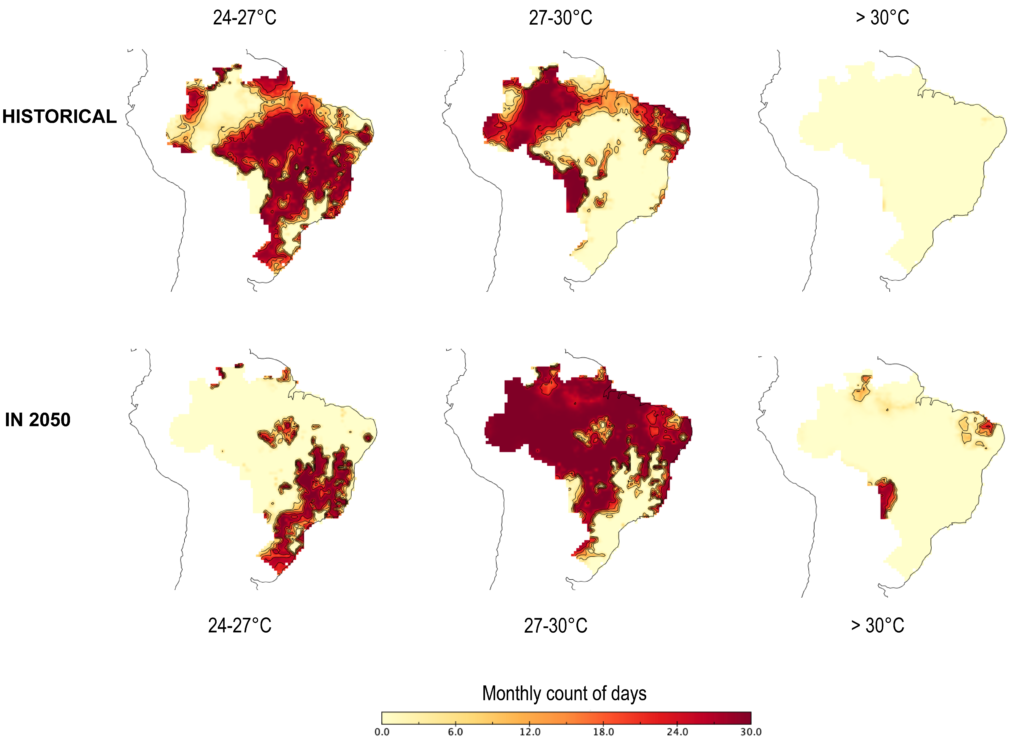| Income-dependent expansion of electricity demand for climate change adaptation in Brazil | |
| Francesco P.Colelli and Malcolm Mistry | |
| Energy and Climate Change , Volume 3, December 2022, 100071 - December 2022 |
In our new study we identify how climate change will influence electricity demand in Brazil over the next 30 years. To do so, we analyze past monthly electricity demand in 27 Brazilian States, breaking down the consumption in households, offices, as well as rural and public buildings.
We develop an empirical model that takes into account the adjustment time needed to purchase new air-cooling appliances (ACs), leading to a quantification of the long-run effects of the exposure to high temperatures. We also look at how different levels of income per capita can change how much power demand increases in response to high temperatures.
First, we find that climate change will increase thermal stress in an already hot country. We measure the variation in the monthly count of days with daily temperatures falling in different intervals (based on data provided by the NASA). Several additional hot days may occur around 2050 in the North, East and Centre-West of Brazil under both moderate (RCP 4.5) and severe (RCP 8.5) warming scenario.

Historical: mean across 21 models and years 1986-2005; Future: mean across 21 models and years 2041-2060 in RCP 4.5.
We show that electricity demand may increase considerably around 2050 due to climate change. During summer months, demand may bump by as high as 30% in the whole country and 50% in the most exposed States. The growth of the middle class amplifies the impact of climate change, as it increases the ability of families and businesses to buy new ACs. The increase in per capita income in 2050 from its current level triples the additional power required to adapt to climate change.
The residential and commercial sectors are affected the most by the interaction between climate and socio-economic developments, while public and rural buildings are characterized by milder long-run shocks.
We find a remarkable heterogeneity in the additional electricity demand required to adapt to climate change in each State.
States in the North (Acre, Amapa, Amazonas, Para, Rondonia, Roraima, and Tocantins), and Centre-West (Distrito Federal, Goias, Mato Grosso, Mato Grosso do Sul) experience the highest increases in the per capita yearly demand, while the highly populous states in the South-West (Espirito Santo, Minas Gerais, Rio de Janeiro, Sao Paulo) account for a very large portion of additional demand.
We quantify the benefits of mitigation policies by measuring the reduction in energy demand expenditures from a scenario with severe warming to one with moderate warming. These savings are non-negligible, being between 1 – 2 billion $ / year, depending on the socio-economic scenario (using current electricity prices).
As the amplification of climate change impacts due to per capita income growth can plausibly characterize other world areas, expanding this analysis to other rapidly growing tropical economies would be of great importance. This aspect is underscored by another recent publication, that studies ACs purchases and electricity demand using household-level data. The study’s results, in line with our new paper, indicate that a household’s ability to adapt to climate change through the use of energy is strongly linked to its socio-economic condition.
